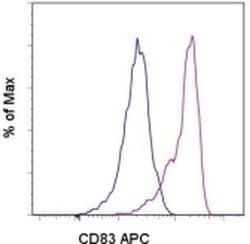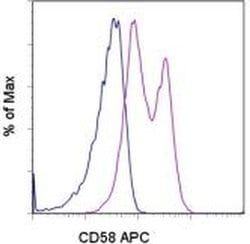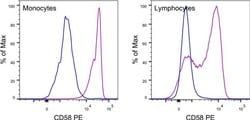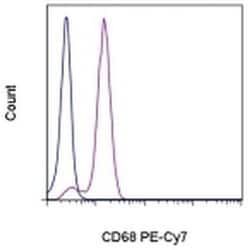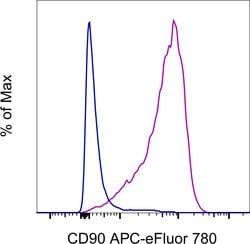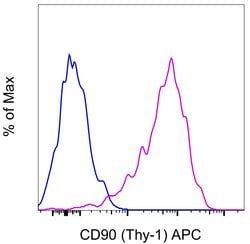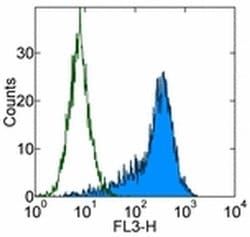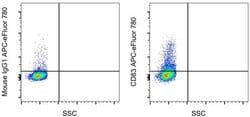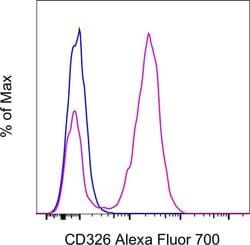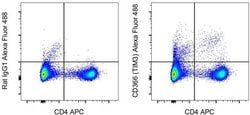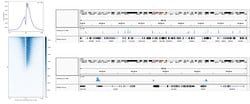7192856
CD83 Monoclonal Antibody (HB15e), APC-eFluor™ 780, eBioscience™, Invitrogen™
Mouse Monoclonal Antibody
Manufacturer: Fischer Scientific
The price for this product is unavailable. Please request a quote
Antigen
CD83
Concentration
5 μL/Test
Classification
Monoclonal
Form
Liquid
Regulatory Status
RUO
Formulation
PBS with 0.2% BSA and 0.09% sodium azide; pH 7.2
Gene Alias
B-cell activation protein; BL11; CD antigen CD83; CD83; CD83 antigen; CD83 antigen (activated B lymphocytes, immunoglobulin superfamily); CD83 molecule; cell surface protein HB15; cell-surface glycoprotein; HB15; hCD83; mCD83
Gene Symbols
CD83
Primary or Secondary
Primary
Content And Storage
4° C, store in dark, DO NOT FREEZE!
Gene
CD83
Clone
HB15e
Applications
Flow Cytometry
Conjugate
APC-eFluor 780
Host Species
Mouse
Target Species
Human
Gene Accession No.
Q01151
Gene ID (Entrez)
9308
Isotype
IgG1 κ
Purification Method
Affinity chromatography
Product Type
Antibody
Description
- CD83 cell surface antigen is a 40-45kD glycoprotein expressed by peripheral blood dendritic cells
- Peripheral lymphocytes can be induced to express very low levels of CD83 after culture in agents such as Con A or PHA
- In immunohistology, CD83 is shown to be expressed strongly by interfollicular interdigitating reticulum cells and more weakly by cells within germinal centres
- CD83 is also expressed by Langerhan's cells in the skin
- The CD83 antigen is a 186-amino-acid single-chain glycoprotein and this molecule is a member of the immunoglobulin superfamily that is composed of an extracellular V-type Ig-like single domain, a transmembrane region, and a short, 40-amino-acid cytoplasmic tail
- CD83 antigen undergoes extensive post-translational glycosylation, since the determined Mr is twice the predicted size of the core protein
- However, CD83+ cells have a unique cell surface immuno-phenotype that does not correlate with that of T cells, B cells, NK cells, or cells of the myelomonocytic lineage
- CD83+ cells coexpress the highest levels of MHC class II molecules, when compared with other leucocyte lineages
- They also co-express T cell markers (CD2, CD5), B cell markers (CD40, CD78), myeloid cell markers (CD13, CD33, CD36), cytokine receptors as well as other cell surface molecules
- Diseases associated with CD83 dysfunction include plague and Rift Valley Fever.
Compare Similar Items
Show Difference
Antigen: CD83
Concentration: 5 μL/Test
Classification: Monoclonal
Form: Liquid
Regulatory Status: RUO
Formulation: PBS with 0.2% BSA and 0.09% sodium azide; pH 7.2
Gene Alias: B-cell activation protein; BL11; CD antigen CD83; CD83; CD83 antigen; CD83 antigen (activated B lymphocytes, immunoglobulin superfamily); CD83 molecule; cell surface protein HB15; cell-surface glycoprotein; HB15; hCD83; mCD83
Gene Symbols: CD83
Primary or Secondary: Primary
Content And Storage: 4° C, store in dark, DO NOT FREEZE!
Gene: CD83
Clone: HB15e
Applications: Flow Cytometry
Conjugate: APC-eFluor 780
Host Species: Mouse
Target Species: Human
Gene Accession No.: Q01151
Gene ID (Entrez): 9308
Isotype: IgG1 κ
Purification Method: Affinity chromatography
Product Type: Antibody
Antigen:
CD83
Concentration:
5 μL/Test
Classification:
Monoclonal
Form:
Liquid
Regulatory Status:
RUO
Formulation:
PBS with 0.2% BSA and 0.09% sodium azide; pH 7.2
Gene Alias:
B-cell activation protein; BL11; CD antigen CD83; CD83; CD83 antigen; CD83 antigen (activated B lymphocytes, immunoglobulin superfamily); CD83 molecule; cell surface protein HB15; cell-surface glycoprotein; HB15; hCD83; mCD83
Gene Symbols:
CD83
Primary or Secondary:
Primary
Content And Storage:
4° C, store in dark, DO NOT FREEZE!
Gene:
CD83
Clone:
HB15e
Applications:
Flow Cytometry
Conjugate:
APC-eFluor 780
Host Species:
Mouse
Target Species:
Human
Gene Accession No.:
Q01151
Gene ID (Entrez):
9308
Isotype:
IgG1 κ
Purification Method:
Affinity chromatography
Product Type:
Antibody
Antigen: CD326 (EpCAM)
Concentration: 0.2 mg/mL
Classification: Monoclonal
Form: Liquid
Regulatory Status: RUO
Formulation: PBS with 0.09% sodium azide; pH 7.2
Gene Alias: adenocarcinoma-associated antigen; CD326; cell surface glycoprotein Trop-1; DIAR5; EGP; EGP-2; EGP314; EGP40; EPCAM; Ep-CAM; EpCAM1; epithelial cell adhesion molecule; Epithelial cell surface antigen; Epithelial glycoprotein; Epithelial glycoprotein 314; ESA; GA733-2; gp40; hEGP314; HNPCC8; human epithelial glycoprotein-2; KS 1/4 antigen; KS1/4; KSA; Ly74; lymphocyte antigen 74; M1S2; M4S1; major gastrointestinal tumor-associated protein GA733-2; mEGP314; membrane component, chromosome 4, surface marker (35kD glycoprotein); MIC18; MK-1; panepithelial glycoprotein 314; protein 289A; Protein D5.7A; Tacsd1; Tacstd1; TROP1; Trop-1 protein; Tumor-associated calcium signal transducer 1
Gene Symbols: EPCAM
Primary or Secondary: Primary
Content And Storage: 4° C, store in dark, DO NOT FREEZE!
Gene: EPCAM
Clone: G8.8
Applications: Flow Cytometry
Conjugate: Alexa Fluor 700
Host Species: Rat
Target Species: Mouse
Gene Accession No.: Q99JW5
Gene ID (Entrez): 17075
Isotype: IgG2a κ
Purification Method: Affinity chromatography
Product Type: Antibody
Antigen:
CD326 (EpCAM)
Concentration:
0.2 mg/mL
Classification:
Monoclonal
Form:
Liquid
Regulatory Status:
RUO
Formulation:
PBS with 0.09% sodium azide; pH 7.2
Gene Alias:
adenocarcinoma-associated antigen; CD326; cell surface glycoprotein Trop-1; DIAR5; EGP; EGP-2; EGP314; EGP40; EPCAM; Ep-CAM; EpCAM1; epithelial cell adhesion molecule; Epithelial cell surface antigen; Epithelial glycoprotein; Epithelial glycoprotein 314; ESA; GA733-2; gp40; hEGP314; HNPCC8; human epithelial glycoprotein-2; KS 1/4 antigen; KS1/4; KSA; Ly74; lymphocyte antigen 74; M1S2; M4S1; major gastrointestinal tumor-associated protein GA733-2; mEGP314; membrane component, chromosome 4, surface marker (35kD glycoprotein); MIC18; MK-1; panepithelial glycoprotein 314; protein 289A; Protein D5.7A; Tacsd1; Tacstd1; TROP1; Trop-1 protein; Tumor-associated calcium signal transducer 1
Gene Symbols:
EPCAM
Primary or Secondary:
Primary
Content And Storage:
4° C, store in dark, DO NOT FREEZE!
Gene:
EPCAM
Clone:
G8.8
Applications:
Flow Cytometry
Conjugate:
Alexa Fluor 700
Host Species:
Rat
Target Species:
Mouse
Gene Accession No.:
Q99JW5
Gene ID (Entrez):
17075
Isotype:
IgG2a κ
Purification Method:
Affinity chromatography
Product Type:
Antibody
Antigen: CD366 (TIM3)
Concentration: 0.5 mg/mL
Classification: Monoclonal
Form: Liquid
Regulatory Status: RUO
Formulation: PBS with 0.09% sodium azide; pH 7.2
Gene Alias: CD366; FLJ14428; Havcr2; HAVcr-2; Hepatitis A virus cellular receptor 2; hepatitis A virus cellular receptor 2 homolog; kidney injury molecule-3; KIM-3; sCD366; soluble CD366; soluble TIM 3; T cell immunoglobulin mucin 3; T cell immunoglobulin mucin-3; T-cell immunoglobulin and mucin domain containing 3; T-cell immunoglobulin and mucin domain-containing protein 3; T-cell immunoglobulin mucin family member 3; T-cell immunoglobulin mucin receptor 3; T-cell membrane protein 3; Tim3; TIM-3; TIMD3; TIMD-3
Gene Symbols: Havcr2
Primary or Secondary: Primary
Content And Storage: 4° C, store in dark, DO NOT FREEZE!
Gene: Havcr2
Clone: 8B.2C12
Applications: Flow Cytometry
Conjugate: Alexa Fluor 488
Host Species: Rat
Target Species: Mouse
Gene Accession No.: Q8VIM0
Gene ID (Entrez): 171285
Isotype: IgG1 κ
Purification Method: Affinity chromatography
Product Type: Antibody
Antigen:
CD366 (TIM3)
Concentration:
0.5 mg/mL
Classification:
Monoclonal
Form:
Liquid
Regulatory Status:
RUO
Formulation:
PBS with 0.09% sodium azide; pH 7.2
Gene Alias:
CD366; FLJ14428; Havcr2; HAVcr-2; Hepatitis A virus cellular receptor 2; hepatitis A virus cellular receptor 2 homolog; kidney injury molecule-3; KIM-3; sCD366; soluble CD366; soluble TIM 3; T cell immunoglobulin mucin 3; T cell immunoglobulin mucin-3; T-cell immunoglobulin and mucin domain containing 3; T-cell immunoglobulin and mucin domain-containing protein 3; T-cell immunoglobulin mucin family member 3; T-cell immunoglobulin mucin receptor 3; T-cell membrane protein 3; Tim3; TIM-3; TIMD3; TIMD-3
Gene Symbols:
Havcr2
Primary or Secondary:
Primary
Content And Storage:
4° C, store in dark, DO NOT FREEZE!
Gene:
Havcr2
Clone:
8B.2C12
Applications:
Flow Cytometry
Conjugate:
Alexa Fluor 488
Host Species:
Rat
Target Species:
Mouse
Gene Accession No.:
Q8VIM0
Gene ID (Entrez):
171285
Isotype:
IgG1 κ
Purification Method:
Affinity chromatography
Product Type:
Antibody
Antigen: H3K4me3
Concentration: 0.5 mg/mL
Classification: Polyclonal
Form: Liquid
Regulatory Status: RUO
Formulation: PBS with 0.09% sodium azide; pH 7.4
Gene Alias: B0035.7; BUR5; CELE_T10C6.12; CG31613; CG31613-PA; CG33803; CG33806; CG33809; CG33812; CG33815; CG33818; CG33821; CG33824; CG33827; CG33830; CG33833; CG33836; CG33839; CG33842; CG33845; CG33848; CG33851; CG33854; CG33857; CG33860; CG33863; CG33866; Dmel\CG31613; Dmel_CG31613; F07B7.10; F07B7.3; F08G2.2; F17E9.13; F35H10.1; F45F2.4; F54E12.5; F55G1.10; H02I12.7; H3; H3 histone; H3 histone family, member A; H3 histone family, member I; H3 histone family, member K; H3 histone family, member L; H3 histone family, member M; H3 histone, family 2; H3 histone, family 3A; H3 histone, family 3B; H3 histone, family 3B (H3.3B); H3 histone, family 3B.1; H3 histone, family 3C; H3 K4; H3.1-221; H3.1-291; H3.1-I; H3.2; H3.2-221; H3.2-614; H3.2-615; H3.2-616; h3.2a; H3.3A; H3.3B; H3.5; H3/A; H3/b; H3/d; H3/f; H3/i; H3/j; H3/k; H3/l; H3/M; H3/n; H3/o; H3-143; H3-291; H3-3A; H3-3b; h3-5; H3-53; H3-614; H3a; H3b; H3-B; H3C1; H3C10; H3C11; H3C12; H3C2; H3C3; H3C4; H3C6; H3C7; H3c8; H3f; H3-F; H3F1K; H3F2; H3F3; h3f3a; H3F3B; h3f3b.1; H3F3C; h3f3d; H3FA; H3FB; H3FC HIST1H3C; H3FD; H3FF; H3FH; H3FI; H3FJ; H3FK; H3FL; H3FM; H3FN; H3g; H3h; H3i; H3K4; H3Lys4me3; h3r; HHT1; HHT2; his-12; his-16; his-19; his-21; His3; his-3; His3:CG31613; His3:CG31613-PA; His3:CG33803; His3:CG33806; His3:CG33809; His3:CG33812; His3:CG33815; His3:CG33818; His3:CG33821; His3:CG33824; His3:CG33827; His3:CG33830; His3:CG33833; His3:CG33836; His3:CG33839; His3:CG33842; His3:CG33845; His3:CG33848; His3:CG33851; His3:CG33854; His3:CG33857; His3:CG33860; His3:CG33863; His3:CG33866; his-30; his-33; his-43; his-47; his-51; his-53; his-57; his-61; his-65; his-68; his-7; Hist1; Hist1h3a; HIST1H3B; Hist1h3c; Hist1h3d; HIST1H3E; Hist1h3f; hist1h3g; hist1h3g.L; HIST1H3H; Hist1h3i; HIST1H3J; hist2h3; HIST2H3A; Hist2h3b; HIST2H3C; Hist2h3c1; Hist2h3c2; Hist2h3c2-ps; Hist2h3ca1; Hist2h3ca2; HIST2H3D; histone 1, H3a; histone 1, H3b; histone 1, H3f; histone 1, H3h; histone 2, H3a; histone 2, H3c; histone 2, H3c2; histone 2, H3ca2; Histone 3; histone cluster 1, H3a; histone cluster 1, H3b; histone cluster 1, H3f; histone cluster 1, H3g protein L homeolog; histone cluster 1, H3h; histone cluster 2, H3a; histone cluster 2, H3c; histone cluster 2, H3c2; histone cluster 2, H3c2, pseudogene; histone gene complex 1; Histone H2A; Histone H3; histone H3.1; Histone H3.2; histone H3.3; Histone H3.3C; histone H3.5; Histone H3/a; Histone H3/b; Histone H3/c; Histone H3/d; Histone H3/f; Histone H3/h; Histone H3/i; Histone H3/j; Histone H3/k; histone H3/l; Histone H3/m; histone H3/o; Histone H3K4me3; histone variant H3.5; hypothetical protein LOC550262; K06C4.11; K06C4.3; M32461; methyl Histone 3; methyl Histone H3; N2749; PP781; SIN2; T10C6.12; T23D8.6; Trimethyl H3; Tri-methyl H3; Trimethyl Histone H3; Tri-methyl Histone H3; Tri-Methyl-H3 K4; Tri-Methyl-H3 Lys4; Tri-Methyl-Histone H3 K4; Tri-Methyl-Histone H3 Lys4; wu:fa25h06; wu:fa96g06; wu:fb07a08; wu:fb36f01; XELAEV_18028537mg; YBR010W; YBR0201; YNL031C; zgc:110292; zgc:174300; zgc:56193; zgc:56418; zgc:64222; zgc:86731; ZK131.10; ZK131.6
Gene Symbols: H3C1, H3C10, H3C12, H3C14, H3C15, H3C2, H3C7, HHT1
Primary or Secondary: Primary
Content And Storage: Store at 4°C short term. For long term storage, store at -20°C, avoiding freeze/thaw cycles.
Gene: __
Clone: 9HCLC
Applications: ChIP Assay, ChIP sequencing (ChIP-seq), Immunocytochemistry, Peptide Array, Western Blot
Conjugate: Unconjugated
Host Species: Rabbit
Target Species: Human, Yeast
Gene Accession No.: P61830, P68431, Q71DI3
Gene ID (Entrez): 126961, 333932, 8350, 8356, 8357, 8358, 852295, 8968
Isotype: IgG
Purification Method: Protein A
Product Type: Antibody
Antigen:
H3K4me3
Concentration:
0.5 mg/mL
Classification:
Polyclonal
Form:
Liquid
Regulatory Status:
RUO
Formulation:
PBS with 0.09% sodium azide; pH 7.4
Gene Alias:
B0035.7; BUR5; CELE_T10C6.12; CG31613; CG31613-PA; CG33803; CG33806; CG33809; CG33812; CG33815; CG33818; CG33821; CG33824; CG33827; CG33830; CG33833; CG33836; CG33839; CG33842; CG33845; CG33848; CG33851; CG33854; CG33857; CG33860; CG33863; CG33866; Dmel\CG31613; Dmel_CG31613; F07B7.10; F07B7.3; F08G2.2; F17E9.13; F35H10.1; F45F2.4; F54E12.5; F55G1.10; H02I12.7; H3; H3 histone; H3 histone family, member A; H3 histone family, member I; H3 histone family, member K; H3 histone family, member L; H3 histone family, member M; H3 histone, family 2; H3 histone, family 3A; H3 histone, family 3B; H3 histone, family 3B (H3.3B); H3 histone, family 3B.1; H3 histone, family 3C; H3 K4; H3.1-221; H3.1-291; H3.1-I; H3.2; H3.2-221; H3.2-614; H3.2-615; H3.2-616; h3.2a; H3.3A; H3.3B; H3.5; H3/A; H3/b; H3/d; H3/f; H3/i; H3/j; H3/k; H3/l; H3/M; H3/n; H3/o; H3-143; H3-291; H3-3A; H3-3b; h3-5; H3-53; H3-614; H3a; H3b; H3-B; H3C1; H3C10; H3C11; H3C12; H3C2; H3C3; H3C4; H3C6; H3C7; H3c8; H3f; H3-F; H3F1K; H3F2; H3F3; h3f3a; H3F3B; h3f3b.1; H3F3C; h3f3d; H3FA; H3FB; H3FC HIST1H3C; H3FD; H3FF; H3FH; H3FI; H3FJ; H3FK; H3FL; H3FM; H3FN; H3g; H3h; H3i; H3K4; H3Lys4me3; h3r; HHT1; HHT2; his-12; his-16; his-19; his-21; His3; his-3; His3:CG31613; His3:CG31613-PA; His3:CG33803; His3:CG33806; His3:CG33809; His3:CG33812; His3:CG33815; His3:CG33818; His3:CG33821; His3:CG33824; His3:CG33827; His3:CG33830; His3:CG33833; His3:CG33836; His3:CG33839; His3:CG33842; His3:CG33845; His3:CG33848; His3:CG33851; His3:CG33854; His3:CG33857; His3:CG33860; His3:CG33863; His3:CG33866; his-30; his-33; his-43; his-47; his-51; his-53; his-57; his-61; his-65; his-68; his-7; Hist1; Hist1h3a; HIST1H3B; Hist1h3c; Hist1h3d; HIST1H3E; Hist1h3f; hist1h3g; hist1h3g.L; HIST1H3H; Hist1h3i; HIST1H3J; hist2h3; HIST2H3A; Hist2h3b; HIST2H3C; Hist2h3c1; Hist2h3c2; Hist2h3c2-ps; Hist2h3ca1; Hist2h3ca2; HIST2H3D; histone 1, H3a; histone 1, H3b; histone 1, H3f; histone 1, H3h; histone 2, H3a; histone 2, H3c; histone 2, H3c2; histone 2, H3ca2; Histone 3; histone cluster 1, H3a; histone cluster 1, H3b; histone cluster 1, H3f; histone cluster 1, H3g protein L homeolog; histone cluster 1, H3h; histone cluster 2, H3a; histone cluster 2, H3c; histone cluster 2, H3c2; histone cluster 2, H3c2, pseudogene; histone gene complex 1; Histone H2A; Histone H3; histone H3.1; Histone H3.2; histone H3.3; Histone H3.3C; histone H3.5; Histone H3/a; Histone H3/b; Histone H3/c; Histone H3/d; Histone H3/f; Histone H3/h; Histone H3/i; Histone H3/j; Histone H3/k; histone H3/l; Histone H3/m; histone H3/o; Histone H3K4me3; histone variant H3.5; hypothetical protein LOC550262; K06C4.11; K06C4.3; M32461; methyl Histone 3; methyl Histone H3; N2749; PP781; SIN2; T10C6.12; T23D8.6; Trimethyl H3; Tri-methyl H3; Trimethyl Histone H3; Tri-methyl Histone H3; Tri-Methyl-H3 K4; Tri-Methyl-H3 Lys4; Tri-Methyl-Histone H3 K4; Tri-Methyl-Histone H3 Lys4; wu:fa25h06; wu:fa96g06; wu:fb07a08; wu:fb36f01; XELAEV_18028537mg; YBR010W; YBR0201; YNL031C; zgc:110292; zgc:174300; zgc:56193; zgc:56418; zgc:64222; zgc:86731; ZK131.10; ZK131.6
Gene Symbols:
H3C1, H3C10, H3C12, H3C14, H3C15, H3C2, H3C7, HHT1
Primary or Secondary:
Primary
Content And Storage:
Store at 4°C short term. For long term storage, store at -20°C, avoiding freeze/thaw cycles.
Gene:
__
Clone:
9HCLC
Applications:
ChIP Assay, ChIP sequencing (ChIP-seq), Immunocytochemistry, Peptide Array, Western Blot
Conjugate:
Unconjugated
Host Species:
Rabbit
Target Species:
Human, Yeast
Gene Accession No.:
P61830, P68431, Q71DI3
Gene ID (Entrez):
126961, 333932, 8350, 8356, 8357, 8358, 852295, 8968
Isotype:
IgG
Purification Method:
Protein A
Product Type:
Antibody
